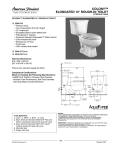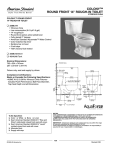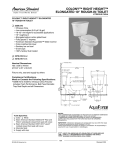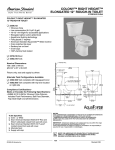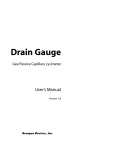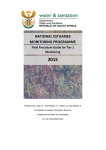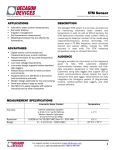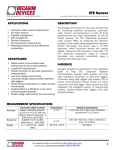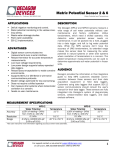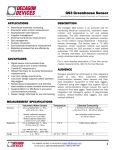Download User's Manual
Transcript
ECHO 2 Dielectric Aquameter User’s Manual For Models EC-20 and EC-10 Version 1.4 Decagon Devices, Inc. ©2002 Decagon Devices, Inc. All rights reserved. Decagon Devices, Inc. 950 NE Nelson Court P.O. Box 835 Pullman WA 99163 ECH2O User’s Manual Contents Contents 1. Introduction . . . . . . . . . . . . . . . . . . . . . . . . . 1 Welcome . . . . . . . . . . . . . . . . . . . . . . . . . . . . 1 ECHO Specifications . . . . . . . . . . . . . . . . . . 1 Contact Information . . . . . . . . . . . . . . . . . . . 2 Warranty Information . . . . . . . . . . . . . . . . . 2 Seller’s Liability . . . . . . . . . . . . . . . . . . . . . . . 2 2. The ECHO Sensor . . . . . . . . . . . . . . . . . . . 4 About the ECHO . . . . . . . . . . . . . . . . . . . . . . 4 Features . . . . . . . . . . . . . . . . . . . . . . . . . . . . . 5 Wiring Diagrams . . . . . . . . . . . . . . . . . . . . . . 5 3.5mm plug wiring . . . . . . . . . . . . . . . . . . . 5 Adapter cable wiring . . . . . . . . . . . . . . . . . 6 3. Installing the Probe . . . . . . . . . . . . . . . . . 7 Procedure . . . . . . . . . . . . . . . . . . . . . . . . . . . . 7 Orientation . . . . . . . . . . . . . . . . . . . . . . . . . 8 Removing the Probe . . . . . . . . . . . . . . . . . . 8 4. Collecting Data . . . . . . . . . . . . . . . . . . . . . 9 Datalogger Requirements . . . . . . . . . . . . . . 9 Connecting to a Datalogger . . . . . . . . . . . 10 Sample Program . . . . . . . . . . . . . . . . . . . . . 10 Calibration . . . . . . . . . . . . . . . . . . . . . . . . . . 13 Troubleshooting . . . . . . . . . . . . . . . . . . . . . 14 Declaration of Conformity . . . . . . . . . . . 15 i ECH2O User’s Manual Contents ii ECHO User’s Manual 2 Introduction 1. Introduction Welcome Welcome to the ECHO Dielectric Aquameter sensor for measuring soil water content. This innovative sensor will enable you to monitor soil moisture accurately and affordably. ECHO Specifications Measurement Time: 10ms (milliseconds) Accuracy: • Typically ± .03 m/m (±3%) • With soil-specific calibration ±.01 m/m (±1%) Resolution: • 0.002m3/m3 (0.1%) Power: • Requirements: 2.5VDC @ 2mA to 5VDC @ 7mA • Output: 10-40% of excitation voltage (2501000mV at 2500mV excitation) Operating Environment: 0 to 50°C Range of Measurement: 0 to saturated volumetric water content Probe dimensions: (model EC-20): 25.4cm x 3.17cm x .15cm (model EC-10): 14.5cm x 3.17cm x .15cm Cable length: 10ft standard, extension cable available Connector type: 3.5 mm plug Datalogger Compatibility (not exclusive): 1 ECHO User’s Manual 2 Introduction • Decagon Em5, Em5R • Campbell Scientific CR10, CR10X, 21X, 23X. Contact Information To contact Decagon for customer support or questions: • Email us at [email protected] • Send us a fax at: (509) 332-5158 • Call us at: 1-800-755-2751 (US and Canada only) or 509-332-2756. Warranty Information The ECHO has a 30-day satisfaction guarantee and a one-year warranty. Seller’s Liability Seller warrants new equipment of its own manufacture against defective workmanship and materials for a period of one year from date of receipt of equipment (the results of ordinary wear and tear, neglect, misuse, accident and excessive deterioration due to corrosion from any cause are not to be considered a defect); but Seller’s liability for defective parts shall in no event exceed the furnishing of replacement parts F.O.B. the factory where originally manufactured. Material and equipment covered hereby which is not manufactured by Seller shall be covered only by the warranty of its manufacturer. Seller shall not be liable to Buyer for loss, damage or injuries to persons (including death), or to property or things of whatsoever kind (including, but not without limitation, loss of anticipated prof2 ECHO User’s Manual 2 Introduction its), occasioned by or arising out of the installation, operation, use, misuse, nonuse, repair, or replacement of said material and equipment, or out of the use of any method or process for which the same may be employed. The use of this equipment constitutes Buyer’s acceptance of the terms set forth in this warranty. There are no understandings, representations, or warranties of any kind, express, implied, statutory or otherwise (including, but without limitation, the implied warranties of merchantability and fitness for a particular purpose), not expressly set forth herein. 3 ECHO User’s Manual 2 The ECHO Sensor 2. The ECHO Sensor About the ECHO The Echo probe measures the dielectric constant of the soil in order to find its volumetric water content. Since the dielectric constant of water is much higher than that of air or soil minerals, the dielectric constant of the soil is a sensitive measure of water content. The ECHO probe has a very low power requirement and high resolution. This gives you the ability to make as many measurements as you want (even hourly) over a long period of time (like a growing season, for example), with minimal battery usage. 4 ECHO User’s Manual 2 The ECHO Sensor Features Circuitry Sensor Fig.1: ECHO probe diagram Wiring Diagrams 3.5mm plug wiring The ECHO probe comes with a 3.5mm “stereo-plug” style connector. This allows for rapid connection directly to Decagon’s Em5 or ECHO Check. Below 5 ECHO User’s Manual 2 The ECHO Sensor is a diagram showing the wiring configuration for this connector. Analog out Ground Excitation Fig. 2: ECHO plug wiring configuration Adapter cable wiring The ECHO adapter cable for connection to nonDecagon equipment contains 3 wires as shown below. The cable plug has integrated inductors designed to provide signal noise reduction. Analog out (Red) Ground (Bare) Adapter cable Excitation (White) Fig. 3: Adapter cable wiring configuration NOTE!: Be aware that cutting off the cable plug or cutting the cable in any other way will void your warranty, since the plug and cable are both specially engineered for optimal performance and noise reduction. 6 ECHO User’s Manual 2 Installing the Probe 3. Installing the Probe When selecting a site for installation, it is important to remember that the soil adjacent to the probe surface has the strongest influence on the probe reading and that the probe measures the volumetric water content. Therefore any air gaps or excessive soil compaction around the probe can profoundly influence the readings. Also, do not install the probes adjacent to large metal objects such as metal poles or stakes. This can attenuate the probe’s electromagnetic field and adversely affect output readings. Procedure To install the ECHO probe, use a thin implement like a trenching shovel, gardening spade, or flat bar to make a pilot hole in the soil. Then insert the probe into the hole, making sure the entire length of the probe is covered. Finally, insert the shovel again into the soil a few inches away from the probe, and gently force soil toward the probe to provide good contact between the probe and the soil. For deeper installation, excavate down to the level you wish to measure, then install the probe. 7 ECHO User’s Manual 2 Installing the Probe Orientation The probe can be oriented in any direction. However, orienting the flat side perpendicular to the surface of the soil will minimize effects on downward water movement. Removing the Probe When removing the probe from the soil, do not pull it out of the soil by the cable! Doing so may break internal connections and make the probe unusable. 8 ECHO User’s Manual 2 Collecting Data 4. Collecting Data Datalogger Requirements The ECHO sensors are designed to work most efficiently with Decagon’s 5-channel Em5 or our ECHO Check handheld readout. They can, however, be adapted for use with other dataloggers, such as those from Campbell Scientific, Inc., for example. The ECHO requires an excitation voltage in the range of 2 to 5 volts. It produces an output voltage that depends on the dielectric constant of the medium surrounding the probe, and ranges between 10 and 50% of the excitation voltage. Any datalogger which can produce a 2.5 to 5V excitation with approximately 10 millisecond duration and read a volt-level signal with 12-bit or better resolution should be compatible with the ECHO probes. The current requirement at 2.5V is around 2mA, and at 5V it is 7-8mA. Important Note: ECHO probes are intended only for use with dataloggers and readout devices which can provide short excitation pulses, leaving the probes turned off most of the time. Continuous excitation not only wastes battery power, but may, under certain circumstances, cause the probe to exceed government specified limits on electromagnetic emissions. 9 ECHO User’s Manual 2 Collecting Data NOTE: All Decagon readout devices use 2.5V excitation, so the remainder of the discussion assumes this as the excitation. If other voltages are used, adjustments to the calibration equations provided will be needed. Connecting to a Datalogger Connect the wires to the datalogger as shown, with the supply wire connected to the excitation, the analog out wire to an analog input, and the bare ground wire to ground: Supply Exc. Analog out Ground L H G Analog In Datalogger Fig. 5: Datalogger configuration Sample Program The following program is an example that can be used with Campbell Scientific’s CR10X datalogger and our ECHO probes at a 2500mv excitation: Note: Multiplier and offset in instruction 2 (P4) convert mV reading to % water content. Instruction 7 (P37) converts % volumetric water content to m3 m-3. Also, "--" (such as the one in Instruction 4 10 ECHO User’s Manual 2 Collecting Data (P89), line 1) increment the input location for the next time through the loop. A "--" is applied to the input location by clicking on the input location # and typing the letter "c". ; {CR10X} ; ECH2O Datalogger Program for CR10X ; Wiring: ; ; ; White: Excitation Channel 1 Red: Input Single Ended Channel 1 Black: Ground *Table 1 Program 01: 1 Execution Interval (seconds) ; Excites and reads two probes once per hour 1: 1: 2: 3: If time is (P92) 0 Minutes (Seconds --) into a 60 Interval (same units as above) 30 Then Do ; ; ; Multiplier and offset Convert mV reading to percent water content with factory calibration: ; y = 6.95E-04 * x - 2.90E-01 ; for ECHO-10 (short probes) use: ; y = 9.36E-04 * x - 3.76E-01 2: Excite-Delay (SE) (P4) 11 ECHO User’s Manual 2 Collecting Data 1: 2: 3: 4: 5: 6: 7: 8: 9: ; ; 2 5 1 1 1 2500 1 0.0695 -29.0 Reps 2500 mV Slow Range SE Channel Excite all reps w/Exchan 1 Delay (units 0.01 sec) mV Excitation Loc [ Probe_mV ] Mult Offset Sets zero as lower limit for water content reading 3: Beginning of Loop (P87) 1: 0 Delay 2: 2 Loop Count 4: 1: 2: 3: 4: If (X<=>F) (P89) 1 -- X Loc [ Probe_mV 4 < 0.0 F 30 Then Do ] 5: Z=F (P30) 1: 0 F 2: 0 Exponent of 10 3: 1 -- Z Loc [ Probe_mV ] 6: ; End (P95) Converts percent to m3/m3 water content 7: Z=X*F (P37) 12 ECHO User’s Manual 2 Collecting Data 1: 1 2: .01 3: 3 8: ; -- X Loc [ Probe_mV F -- Z Loc [ Probe_WC ] ] End (P95) Stores reading in final storage location 9: Do (P86) 1: 10 Set Output Flag High (Flag 0) 10: Sample (P70) 1: 2 Reps 2: 3 Loc [ Probe_WC 12: ] 11: Do (P86) 1: 20 Set Output Flag Low (Flag 0) End (P95) *Table 2 Program 02: 0.0000 Execution Interval (seconds) *Table 3 Subroutines End Program Calibration The ECHO probes come pre-calibrated for most soil types. If, however, your soil type has high sand or salt content, the standard calibration will not be accurate. In such cases, you can perform specific calibrations for your individual soil types. The standard calibration for the standard 25cm length (EC-20) ECHO probes with a 2500mV excitation is 13 ECHO User’s Manual 2 Collecting Data θ (m3/m3) = 0.000695mv - 0.29 and for the shorter (ECHO-10) probes is: θ (m3/m3) = 0.000936mv - 0.376 where θ is the volumetric water content and mv is the millivolt output of the ECHO probe. NOTE!: This calibration constant is only for use with a 2500mV excitation. Use of this number with any other excitation voltage will result in erroneous readings! Troubleshooting If you encounter problems with the ECHO probe, they most likely will manifest themselves in the form of incorrect or erroneous readings. Before contacting Decagon about the sensor, do the following: • Check to make sure the connections to the datalogger are both correct and secure. • Ensure that your datalogger’s batteries are not dead or weakened. If you encounter problems that aren’t due to the datalogger, please contact Decagon at (509) 3322756 and at [email protected]. 14 ECHO User’s Manual 2 Declaration of Conformity Declaration of Conformity Application of Council Directive: 89/336/EEC Standards to which conformity is declared: EN61326 : 1998 EN55022 : 1998 Manufacturer’s Name: Decagon Devices, Inc. 950 NE Nelson Court Pullman, WA 99163 USA Type of Equipment: ECHO dielectric soil moisture probe. Model Number: EC-10, EC-20 Year of First Manufacture: 2001 This is to certify that the ECHO dielectric soil moisture probe, manufactured by Decagon Devices, Inc., a corporation based in Pullman, Washington, USA meets or exceeds the standards for CE compliance as per the Council Directives noted above. All instruments are built at the factory at Decagon and pertinent testing documentation is freely available for verification. 15 ECHO User’s Manual 2 Declaration of Conformity 16




















